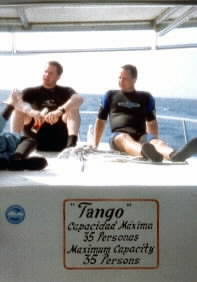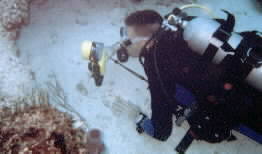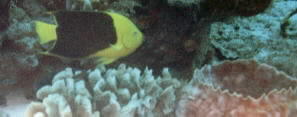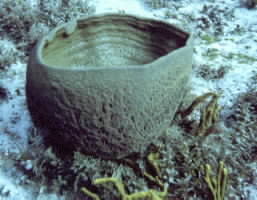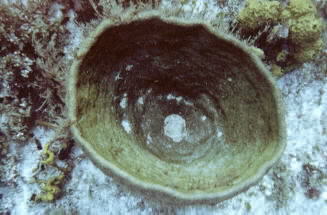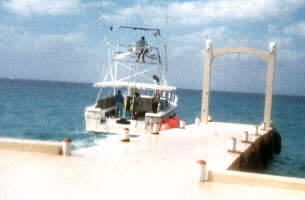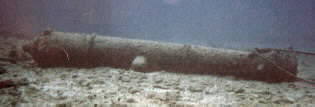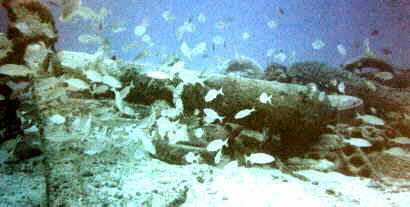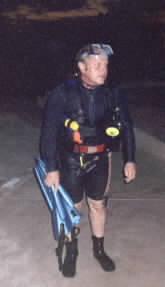The Last Day of Diving
We break camp early and head for Loretto for our last day of
diving. After the dive we will drive to San Ignacio on the first leg of our
journey back to San Diego. We pack the truck as best we can, but in our short
time here our possessions seem to have expanded beyond the limits of our cargo-carrying
capacity. We won’t leave anything behind except the unburned firewood, which we
figure will be quickly claimed. A little creative rearrangement and we are on
the way. I speculate that there may be more sand in the truck than on the
beach.
We arrive at the El Presidente just before 8 o’clock,
stopping along the way to shoot a couple of photographs of the beach which has
been our base of operations for the last several days. I am shooting into the
light as the sun rises over the mountains, silhouetting the peaks the locals
call "goat tits" a name which requires no further explanation.
Our panga today is named Lourdes, which is a shrine in
France to the incurably sick whose spring waters are said to provide miraculous
cures. I speculate that the same can be said for the waters of the Sea of
Cortez, given the way I feel right now.
We are diving without the divemaster
today. He is in another panga, escorting divers from Colorado who showed up
with neon-hued divebags pulled from a car plastered with environmentalist-themed
bumper stickers. In contrast, we put our tanks and gear on board the panga,
after all, we are not resort divers who expect everything to be loaded for
them. We push the beached panga into the water. and hop over the freeboard into
the boat. Pangas are pulled across logs onto the beach by truck and must be
manhandled back down to the water to be launched.

We motor down the coast, past our recently abandoned
campsite at Juncalito on the way to our first dive site, Piedra Cameron. From
offshore, the area where we snorkeled the day before is just another
indistinguishable stretch of coastline. Piedra Cameron is a submerged rock that
rises to within 20 feet of the surface and then drops off dramatically to a
depth of about 100 feet. Visibility was about 60 feet. We hung out at around 45
feet for nearly an hour, as if to stretch these last dives as long as possible.
The second dive at nearby Punta Elanor lasted more than an hour, but we were a
bit shallower, with most of the dive taking place at about 35 feet. Both dives
were so phenomenal as to defy description.
The Taco Stand
The dives over, we headed back for Loretto, beaching the
boat and removing our gear. We cleaned it at a nearby plaza that had a fresh
water rinse. We then drove into Loretto proper in search of lunch and
discovered a wonderful fish taco stand with a few tables. An elderly woman
served us plate after plate of tacos. She did so cheerfully, but I got the
impression that we were keeping her from her Spanish-language soap opera, telenovela, that
played from a portable black and white T.V. on the counter. She would no sooner
sit down and we would order another three plates of tacos and a round of Pepsi,
having gulped down the previous serving. She must have thought that we had not
eaten in a week the way we tore into those tacos. The bill rolled up at 7,000
pesos a plate, about $2.50 at the exchange rate in effect at the time.
Many year Brandon was in Loretto on an underwater photo shoot. The taco stand is still there run by the same woman that served us years before. He sent me a bumper sticker from the stand.
The Diving is Over--Time to Head Home
We left Loretto and raced for San Ignacio, making a fueling
stop in Mulege, during which we observed a religious procession featuring a
statue of the Virgin of Guadalupe, the patron saint of Mexico. After the
procession passed, we were once again heading toward San Ignacio.
Approaching
the town, we decided to press on for Guerro Negro. We covered 258 miles since finishing our last plate of tacos. With the diving done, we wanted to get home.
That night, we camp in an R.V. parking area behind a
restaurant-bar-hotel on the outskirts of the city. We park on a concrete slab.
I claim the back of the truck under owner’s prerogative, Brandon grabs his
mummy bag and stretches out on the slab, while Andy seeks refuge from the cold
wind off the nearby Pacific Ocean by crawling under the front of the truck,
where the engine block is radiating its residual heat.
After nearly a week of
primitive camping, this slab is almost a five-star location as the outbuilding
has flush toilets and hot showers. After two dives and a long drive, sleep
comes quickly. The thumping of the bass from the band playing in the nearby bar
makes for a peculiar lullaby. I am awakened at closing time as more than a few
people meander past the slab. Apparently we made camp beside the trail that
connects the bar to the nearby neighborhood.
Thursday, December 13, 1990
The next morning, we head for the border, taking only time
to refuel and wolf down a few candy bars with a lemon-lime Gatorade chaser. The
odometer clicks up the 463 miles as the roadsigns count down the kilometers to
Tijuana and the international border crossing.
Traffic at the border slows to a
crawl and we are entertained by the moving bazaar of barkers hawking their
trinkets to the car-bound captive audience. Mixed in with the merchants are
kids looking to clean your windshield while others in the guise of priests,
nurses, and rescue crews pass by with white buckets with appeals to various
charitable endeavors. I wonder if the fund raisers change costumes from day-to-day
to assume various roles. The first one to pass my car gets my last three 500
peso notes. The currency will be virtually useless once we cross the border.
We approach the Customs booth and present our passports to
the agent. We must be a sorry sight, unshaven and in clothes that we have been
in since breaking camp the day before. The Customs officer asks me "what was the
purpose of your visit to Mexico" and "do we had anything to declare."
I answered "we
were camping and scuba diving and about the only thing we had to declare was a
blanket purchased in Mulege."
He asked to see what we had in the back of the
truck. He inspected the bags with our dirty laundry. For a moment, he seemed to
be looking for designer label knockoffs among our possessions. I swear, there
was not a designer label among the three of us, unless none-to-clean J.C. Penny
tighty whitey briefs, Hanes tee shirts, and worn Levis jeans are considered
high fashion.
I remembered my late mother’s admonition to always wear clean
underwear to hold up the honor of the family in case of accident and though how
disappointed she would be to the point of disowning me if the agent decided to
check.
After a period of time that the agent must have
considered adequate to ensure that we were not smuggling contraband,
we were unceremoniously waved through without so much as a "welcome
home" or "drive safely."
Upon crossing the border, I ejected the REM tape that had
been playing for the last hour. (I still have the cassette and play it on the way to Seward when I dive at the Alaska Sea Life Center.) Since leaving the States, we had played a
selection of tapes ranging from big band to classical to rock. The radio
carried news of foreign workers held hostage in Iraq, diplomatic initiatives,
and continuing mobilization for what seemed like an inevitable conflict. We
were back to reality. The world could have disappeared for the days we were
incommunicado. I had a great week in the bush, diving with two friends, the
kind of people you don't mind sharing a campfire with.
That night we enjoyed grilled steak and spaghetti back at
Andy’s apartment.
Friday and Saturday, December 15 and 16, 1990
We did a couple of beach dives the next day Friday, checking out La
Jolla Canyon and La Jolla Cove. Like all addicts, we needed one more fix.
Withdrawal was delayed another day for Brandon and I as we dove from Rick
Cassen’s boat, America, out of Mission Bay on Wreck Alley and the NOSC Tower,
which with its truss structure felt like we were diving on a big underwater
jungle gym. We then headed back for Goleta. These dives were interesting, but will be absent from this narrative
of our makeshift expedition of the Baja desert coast of the Sea of Cortez. They after all are part of the continuing story of my adventures.










